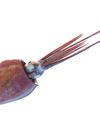
More than 80 per cent of the world's oceans are yet to be explored and mapped, meaning there's a lot we don't know about what lies beneath the surface. To say that the world's oceans are vast would be an understatement. Around 79 per cent of the entire biosphere of our planet is made of water that's 1,000 metres deep, and the place where the ocean reaches its deepest point is seven miles from the surface. Known as the Mariana Trench, this is a crescent-shaped trough that runs for more than 1,550 miles along the length of the Western Pacific Ocean.
It was first discovered in 1875 by HMS Challenger after sailors dropped a weighted rope about five miles into the ocean. In 1951, HMS Challenger II returned to the same spot and determined that there were two more miles to go before reaching the bottom. In 2012, Titanic director James Cameron descended to the Mariana Trench in a one-person submarine called Deepsea Challenger and spent four hours at a depth of seven miles below the surface, witnessing the deepest waters on Earth.
Life in the deep ocean exists in one of two places: the benthic zone or the pelagic zone. The benthic zone refers to the sedimented bottom or seafloor, whereas the pelagic zone is everywhere else - the open water of the ocean. These two general zones have subzones within them that describe the layers of the ocean moving down towards the deepest point on the planet, the Mariana Trench. Beyond the uppermost layer of the ocean, known as the epipelagic or sunlight zone, life has evolved to adapt to life in the cold, dark extremes of the deep sea.
هذه القصة مأخوذة من طبعة Issue 176 من How It Works UK.
ابدأ النسخة التجريبية المجانية من Magzter GOLD لمدة 7 أيام للوصول إلى آلاف القصص المتميزة المنسقة وأكثر من 9,000 مجلة وصحيفة.
بالفعل مشترك ? تسجيل الدخول
هذه القصة مأخوذة من طبعة Issue 176 من How It Works UK.
ابدأ النسخة التجريبية المجانية من Magzter GOLD لمدة 7 أيام للوصول إلى آلاف القصص المتميزة المنسقة وأكثر من 9,000 مجلة وصحيفة.
بالفعل مشترك? تسجيل الدخول

INCREDIBLE SOLAR SYSTEM CRATERS
Why these spectacular craters carved out by past impact events are among the most widespread and distinctive geological features in the Solar System

HOW NORTH AMERICA'S GREAT LAKES FORMED
The world's largest freshwater system comprises five immense interconnected lakes, carved into Earth by glaciers

BUILDING THE WORLD'S DEEPEST CAR PARK
Australia's most famous landmark is often marvelled at from ground level, but its innovative spiral substructure is a hidden gem

FINDING THE COLOSSAL SQUID
This elusive creature spawned a legend of a deep-sea monster that endured for centuries

Octopuses burn more calories changing colour than you do on a 23 minute run
For octopuses, changing colour burns about as many calories as a human on a 23-minute run. Octopuses are masters of disguise, changing colour at the drop of a hat to startle predators and hide from prey.
The world's first silicon-anode battery could revolutionise electronic vehicles
A ceramic battery manufacturer has unveiled a solid-state battery concept that can be charged from 5 to 60 per cent capacity in just five minutes, giving future electric vehicles (EVS) a 186-mile range in the time it takes to order a coffee.

New technology gives AI the power to feel surfaces
Scientists have given artificial intelligence (AI) the capacity to 'feel' surfaces for the first time, opening up a new dimension for deploying the technology in the real world.

Visit Plane Earth 2125
How might our world have transformed under the strain of climate change 100 years from now?

The world's largest organism may have been growing for 80,000 years
Pando, an enormous quaking aspen that spans more than 40 hectares in Utah, is not only one of the largest known organisms on Earth, it's also one of the oldest.

Scientists detect the most powerful cosmic rays ever
Scientists have detected the most energetic cosmic rays ever discovered, and they're being produced by mysterious sources relatively close to Earth.